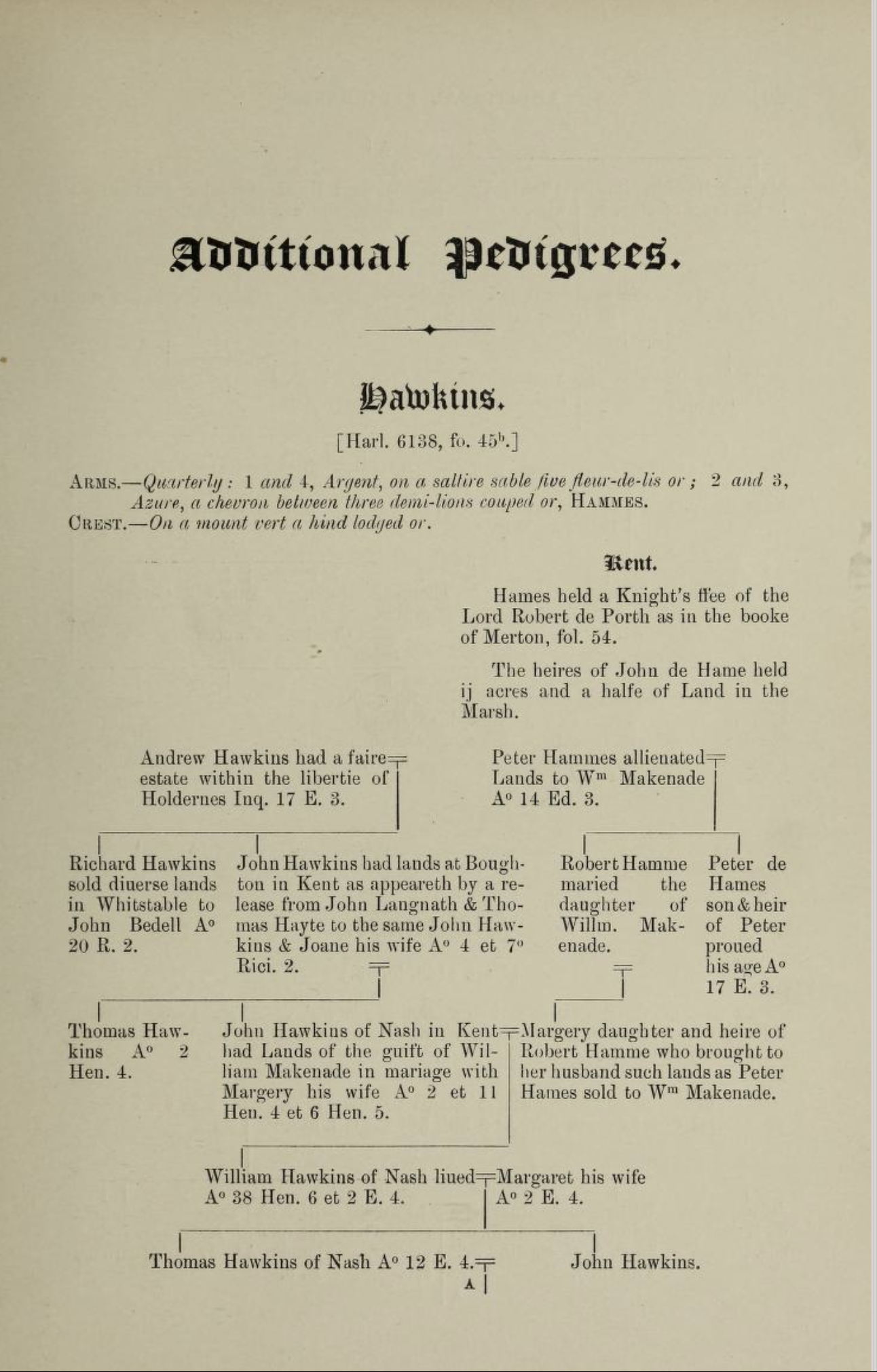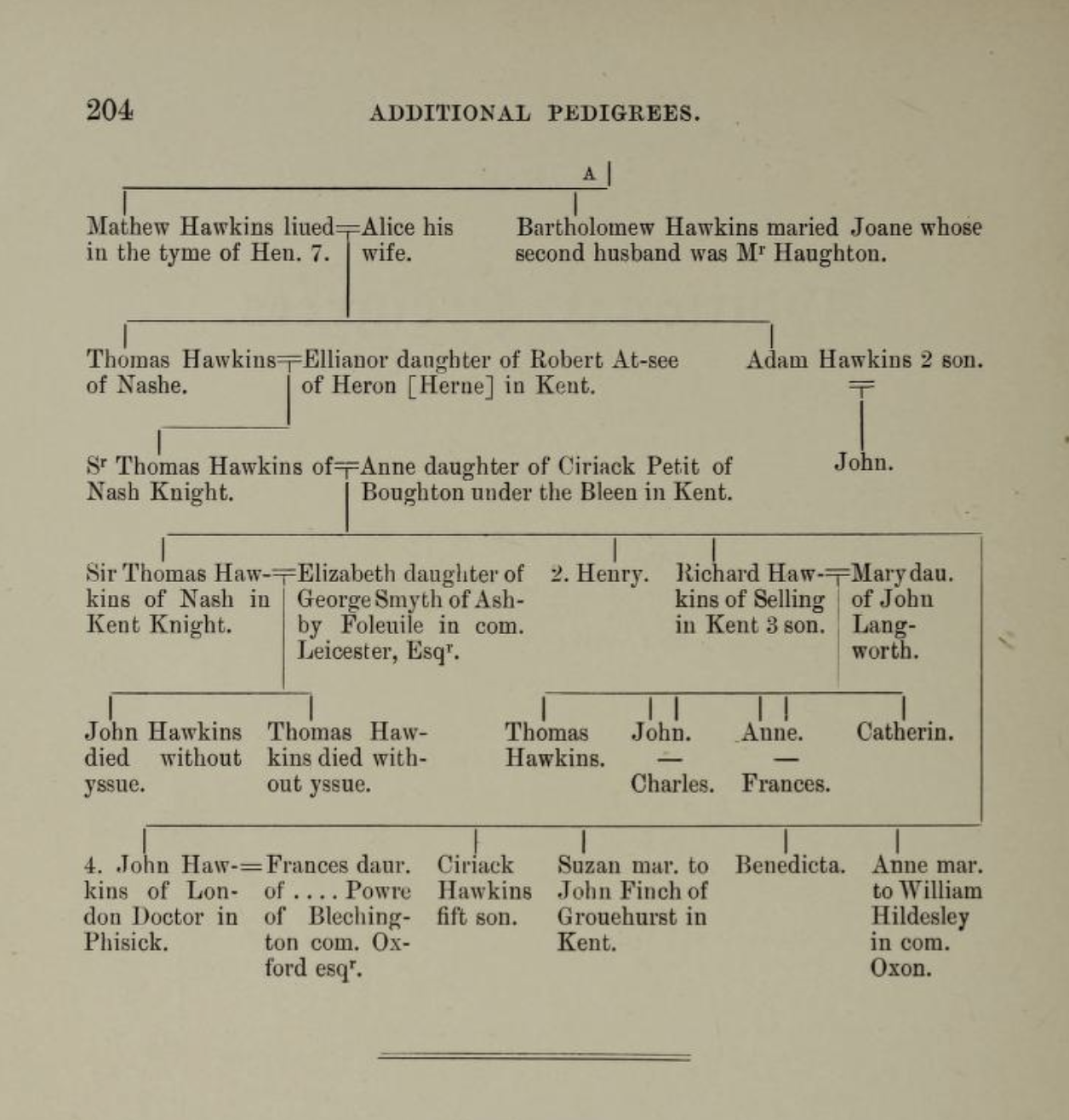
VisOfKentHaw...

VisOfKentHaw...

Richard was born about 1332 in Kent, England, the son of Andrew Hawkins and Joan de Nash.
He died about 1400 in Milton Damerel, Devonshire, England.
His wife was Thomasin Stapledon. They were married, but the date and place have not been found. Their only known child was Richard (1397-c1437).
William [Hawkins], de Northwood, de Hokeswod, de Flegh | John [Hotchkiss / Hawkins], de Northwod, de Hoxwode, de Flegh | |||||||
| | ||||||||
| | | |||||||
| | ||||||||
| | | |||||||
| | ||||||||
| | | |||||||
| |
| Event | Date | Details | Source | Multimedia | Notes | ||
|---|---|---|---|---|---|---|---|
| Birth | ABT 1332 |
| |||||
| Death | ABT 1400 |
|
 VisOfKentHaw... |  VisOfKentHaw... |
Note 1
!StyleName: Hawkins / Hankeford, Sir Richard, I., of Whitstable in Kent & Milton Damerel in Devon, KB, Lord Chief Justice of England [abt 1300 - aft 1387]
!Note: Sir Richard Hawkins, son of Andrew Hawkins of Preston in Holderness and Nash in Kent, held substantial land in Whitstable and is recorded selling property there as late as 1387. Though he is not recorded with children in the Kent visitation pedigrees, a Devon Inquisition Post Mortem for "Richard Haukeford" in 1437 suggests lingering claims to his property. The 40+ year delay may reflect dower rights held by a widow, or complex inheritance proceedings. What is certain is that his estate did not vanish — it passed eventually to his brother John Hawkins I of Nash’s descendants, notably Thomas and William . William’s son, Vicar John Hawkins , is the first verified Hawkins to live and serve in Devon, firmly anchoring the line there. This makes Sir Richard’s property the likely foundation for the long-standing Devon Hawkins branch.
!Note: Hankeford and Hankessok are likely regional or scribal misreadings of Hawkins, where the "wk" is mistaken for "nk", and the Anglo-Saxon scribes substituted endings to avoid the soft "kis/kins" form. Likely unique to Wiltshire and nearby counties during the 14th–15th centuries.
!Note: Name Confusion Warning:
Several knights of the Hawkins family were recorded as “Hankford” in official titles, particularly in Devon records. This likely stems from a scribal misreading during knighthood documentation, compounded by estate associations. Contemporary family and Kent records retain “Hawkins,” but formal documents reflect the Hankford variation due to inherited title usage. They are the same people.
!Source: Inquisitions Post Mortem, Edward II, File 65 https://www.british-history.ac.uk/inquis-post-mortem/vol6/pp139-149
244. ANDREW HAUKYN of Preston in Holdernesse.
Writ. 3 July, 13 Edward II. [25 Apr 1307-1327, so 3 Jul 1320]
[YORK.] Thursday the eve of the Assumption, 14 Edward II.
Preston. A messuage, 1/2a. and 1r. land, and a toft and 6a. land, 2a. 1r. meadow, and pasture for a fat beast in the ox marsh held jointly with Stephen Haukyn his brother who survives, and the heirs of the said Andrew, of the king in chief, as of the honour of Albemarle, by knight’s service.
Margery his daughter, aged 2 1/2, is his next heir.
C. Edw. II. File 65.
!Source: The visitation of Kent : taken in the years 1619-1621, page 202, by John Philipot, Rouge Dragon, Marshal and Deputy to William Camden, Clarenceux., edited Robert Hovenden, F.S.A., London 1989. [Public Library of Boston]
archive.org/details/visitationofkent00camd/page/n7/mode/2up?view=theater
Additional Pedegrees. Hawkins. [Harl. 6138, fo. 45th.]
Arms. — Quarterly : 1 and 4, Argent, on a saUire sable five fleur-de-lis or ; 2 and 3,
Azure, a chevron, between three demi-lions couped or, Hammes. Chest. — On a mount vert a hind lodged or.
Andrew Hawkins had a faire estate within the libertie of Holdernes Inq. 17 E. 3.
Son: Richard Hawkins sold diuerse lands in Whitstable to John Bedell A^ 20 R. 2. [1387]
Son: John Hawkins had lands at Boughton in Kent as appeareth by a release from John Langnath & Thomas Hayte to the same John Hawkins & Joane his wife A" 4 et 7" Rici. 2 [1374]
!Source: A Hawkins Genealogy Volume 2, Record of the Descendants of Robert Hawkins of Charleston, Massachusets, by Ralph Clymer Hawkins, photocopy from original at New England Historic Genealogical Society, 101 Newbury Street, Boston, Massachusetts 02116, appears dated June 1973.
https://www.google.com/url?sa=t&source=web&rct=j&opi=89978449&url=https://archive.org/download/hawkinsgenealogy02hawk/hawkinsgenealogy02hawk.pdf&ved=2ahUKEwii9ObSudGMAxWxODQIHXgMKLw4HhAWegQIHBAB&usg=AOvVaw3srpGPSvgAVMqYgkacIPAs
-
The first of them that I find mention of, is Andrew Hawkins, who had a fair estate in the Liberty of Holdness in the co. of York, as appears by an inquisition taken anno 17 Edward III [1343-4], and left issue by his wife [Fake wife and estate was here, see below], two sons, Richard, and John, the latter of whom purchased divers lands in Boughton in the beggining of the reign of King Richard II [1367-1399].
-
He [John] left issue by Jane his wife, two sons, >>> Thomas <<< who was living in the beginning of King Henry IV’s reign [1399-1413], and
John, who was of Nash and had lands of the gift of William Makenade and Margery his wife, who was daughter and heir of Robert Hanes, and brought her husband such lands as Peter Hanes sold to William Makenade above mentioned. He died at the beginning of K. Henry VIth reign [1422-1461 and 1470-1471, and left issue william Hawkins, who resided at Nash- the 12th year of King Edward IV [1442-1487 so 1454].
Note: Picked birth year so that he was of age for the above mentioned inquisiton in 1343-4.
!Source: THE HISTORY AND TOPOGRAPHICAL SURVEY OF THE COUNTY OF KENT CONTAINING THE ANCIENT AND PRESENT STATE OF IT, CIVIL AND ECCLESIASTICAL ; COLLECTED FROM PUBLIC RECORDS, AND OTHER AUTHORITIES: ILLUSTRATED WITH MAPS, VIEWS, ANTIQUITIES, 8cc. THE SECOND EDITION, IMPROVED, CORRECTED, AND CONTINUED TO THE PRESENT TIME. By EDWARD HASTED, Efq F. R. S. and S. A.
https://upload.wikimedia.org/wikipedia/commons/c/c5/The_history_and_topographical_survey_of_the_county_of_Kent_%28IA_b28772155_0008%29.pdf
-
The manor of Whitstaple, called formerly, as
above mentioned, North'wood, alias Whistaple, toge-
ther with the hundred and the church of Whitstaple
appendant, feems to have been in very early times part
of the poffeffions of the fame owners that the barony of
Chilham had, and to have continued in like manner in
the defcendants of Fulbert de Dover. In king Henry
the Illd.’s time I find it .
This transaction likely did not involve the manor itself, which was in capite , but subinfeudated lands — i.e., parcels that had been granted to the Hawkins family as tenants or sub-tenants.
The Hawkins family held land within the manor of Northwood/Whitstable but were not lords of the manor itself. Their holdings may have been:
- Copyhold or customary tenure, granted by the lord of the manor.
- A sub-feoffment, potentially dating from the early 1300s or even inherited through marriage or service — such as military service, fitting our working theory of service under Dover Castle or Northwode overlords.
-
Why This Matters:
This lends additional credibility to our broader theory:
Richard Hawkins’ 1387 sale shows that the family retained recognizable land in Whitstable, consistent with descent from Andrew Hawkins .
The absence of a recorded acquisition and the clear existence of their land in an established manor supports the argument that this land was retained property — likely dating back to the period when William de Hokeswod/Flegh/Hawkins gave up Hawkinge but kept Nash and Whitstable.
!Source: LANDOWNERSHIP South West Heritage Trust https://swheritage.org.uk/wp-content/uploads/2021/09/Norton-Fitzwarren-Landownership.pdf
NORTON MANOR
Norton may have been among the lands in Somerset granted in 882 by Alfred, king of the
Saxons, to his thegn Æthelstan.9 In 1066 Norton Fitzwarren was held by Osmund, and it paid
geld for 5 hides. By 1086 it was part of the estates of the Count of Mortain and was held by
Alvred.10 This Alvred was Aluredus Pincerna, Alured or Alfred the Butler, the wealthiest of
the Count of Mortain’s tenants, with most of his land being held in south-west England.11 His
estate at Chiselborough, and presumably that of Norton, descended through the family to his
great-grandson John, surnamed de Montague .12 In
1210 John held manors including those of Norton and Chiselborough of the king, the rent for
Norton being £7 4s. 1d.13 The manor of Norton was held by him in 1212 for one knight’s fee
of the honour of Mortain.14
,…,
When Peter died in 1391 his heir was his son Sir Thomas but under the 1385
settlement Norton should have passed to Henry, his son by Eleanor.46 Possibly taking
advantage of the situation Richard Stapeldon gained possession of the manor and in 1393
John le Veel, presumably brother of Thomas, with some companions entered the manor by
force and expelled Stapeldon’s men and servants.47 Enquiries into the case were still ongoing
in 1397–8.48 In 1401 another assault was made on the manor, thrusting out the servants of
Richard, son of Richard Stapeldon and fixing iron bars before the gates.49 However, the Veel
family were unsuccessful in their attempts to regain the manor. >>> The younger Richard
Stapeldon died c. 1396 leaving a widow Margaret50 and a daughter Thomasine who married
Sir Richard Hankeford of Annery in Devon, son of Sir William Hankeford , Chief Justice of the King’s Bench. <<<
>>> Richard Hankeford was in possession of the manor by 1404 52 and in 1412 he held
lands in Norton, valued at £40.53 After the death of his wife Thomasine he held her estates for
life.54 On his death in 1419 his son, also Richard , inherited the Norton estate. <<< By his
first wife Elizabeth, daughter of Fulk, Lord Fitzwarren, the younger Richard inherited further
estates, Lord Fitzwarren’s son Fulk having died a minor without issue. By Elizabeth’s
daughter Thomasine the manor of Norton and the title of Lord Fitzwarren would come by
marriage to William Bourchier, ancestor of the Earl of Bath.55
When Sir Richard Hankeford died in 1431, the reversion of the manor of Norton
Fitzwarren, after the death of Anne, his second wife, was to his daughters by Elizabeth.56
Anne died in 1457, having remarried twice.57 Thomasine , the only surviving child
of Richard by Elizabeth,58 married, before 3 August 1437, William Bourghchier, styled ‘de
fitz Waryn’ by 1449.59 Their son and heir Fulk Bourchier, Lord Fitzwarren
inherited his mother’s lands upon his father’s death in 1469. He married Elizabeth ,
sister and co-heir of John, Lord Dinham , and in 1472 settled the manor on his
wife and her heirs.60 After Fulk Bourchier’s death in 1479 his widow Elizabeth married
secondly John Sapcott and thirdly Sir Thomas Brandon .61 When Elizabeth
died in 1516 her heir was her son John Bourchier, Lord Fitzwarren , created Earl of
Bath in 1536.62 The manor descended with the Earls of Bath like Huntspill until the
beginning of the 18th century.
!Source: Devon Wills Index, 1163-1999 https://www.findmypast.com/transcript?id=GBOR%2FOR%2FDEVWILLS%2F174545&tab=this
First name Richard
Additional information Inquisition Post Mortem;
Last name Hankeford Or Haukeford <<<
Source Taps
Sex Male
Document type Other
Occupation Knight
Document form Abstract or Extract
Probate year 1437
Document references 15 Hen. VI. No. 75
Place Milton Damerel
Record set Devon Wills Index, 1163-1999
Original place Milton Damerel
Category Birth, Marriage & Death
County Devon
Subcategory Wills & Probate
Country England
Collections from Great Britain, England
!Source: The General Armory of England, Scotland, Ireland, and Wales, Sir Bernarf Burke, C.B. LLD., Ulster King of Arms., Published 1996.
Hankford [co. Devon] Sa. on a Chev. ar. another wavy gu.
Hankford [Exeter College;Richard Hankford, Knt., “of the blood and consanguinity of the founder.” Visit 1574]. Ar. two bends nebulèe sa.